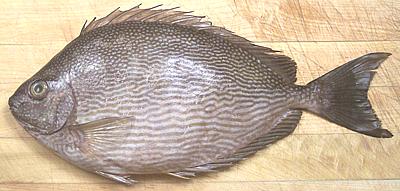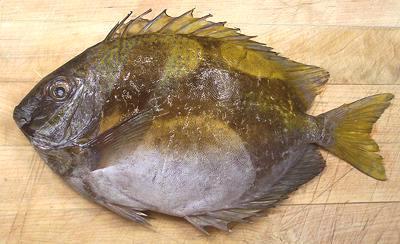 [Streaked Spinefoot (Fishbase / FDA), Java Rabbitfish, Bluespotted
Spinefoot; Siganus javus]
[Streaked Spinefoot (Fishbase / FDA), Java Rabbitfish, Bluespotted
Spinefoot; Siganus javus]
Found in tropic seas from the east coast of Africa to the South Pacific
islands, the Java Rabbitfish is a vegetarian living on algae. It can grow
to 20 inches but the photo specimen was 14 inches and 1.9 pounds, near the
high end for market fish. Predatory fish that feed on rabbitfish can
concentrate ciguatera toxins but rabbit fish themselves have not been
implicated as a risk. Rabbit Fish reproduces quickly and is not listed as
endangered (IUCN Red List NE (Not Evaluated)). They have no conventional
scales so are not kosher.

[Barhead Spinefoot (Fishbase), Virgate Rabbitfish; Siganus virgatus | similar Barred Spinefoot (Fishbase), Pencil-streaked Rabbitfish / Spinefoot: Siganus doliatus]
These two Rabbitfish are very closely related and can interbreed. They also vary tremendously in coloration so are hard to tell apart. The Virgate ranges from the east coast of Africa to the South Pacific islands while the Barred ranges from southern India across the Pacific to the coast of Central America and northern South America. They both go as far south as the northern coast of Australia and as far north as the northern tip of the Philippines. Both are vegetarian, living on seaweed (algae). The Virgate can grow to nearly 12 inches and the Barred to almost 10 inches. Rabbitfish reproduce quickly and are not listed as endangered (IUCN Red List NE (Not Evaluated)). They have no conventional scales so are not kosher.
More on Rabbit Fish.
Rabbitfish is an excellent eating fish with a good, moderate flavor throughout. The flesh stays very firm when cooked by any method and it's good for curries. It flakes apart very easily if poached, so care is needed.
Buying: Java Rabbitfish can almost always be found in fish markets serving a Philippine community, always as whole fish and at an economical price. Virgate Rabbitfish is very rarely seen here in Southern California.
Cleaning: This fish has no scales to scrape off and presents no particular problem for cleaning. The body cavity extends way farther back than the vent but the bottom cut will be long enough to get in there and remove the innards. Handle carefully because some of the spines may be mildly venomous.
Skin: The skin has no strong flavor but it's fairly thick and will shrink enough to curl fillets when fried so it should be removed using the usual long knife and cutting board method.
Fillet: Rabbitfish is very easy to fillet with an easy to follow bone structure. You will lose the least flesh if you cut the ribcage from the backbone with kitchen shears and pull the ribs from the fillet with long nose pliers. They come out easily and cleanly. The centerline spines are softer than on most fish but should be pulled for the length of the body cavity, particularly on larger fish.
Yield: A 14 inch 1.9 pound fish yield 12 oz of skinless fillet (40%).
Stock: The head, fins and bones make a slightly oily stock that is stronger flavored than you'd probably want for soup.
sf_rabbitz 070107 - www.clovegarden.com